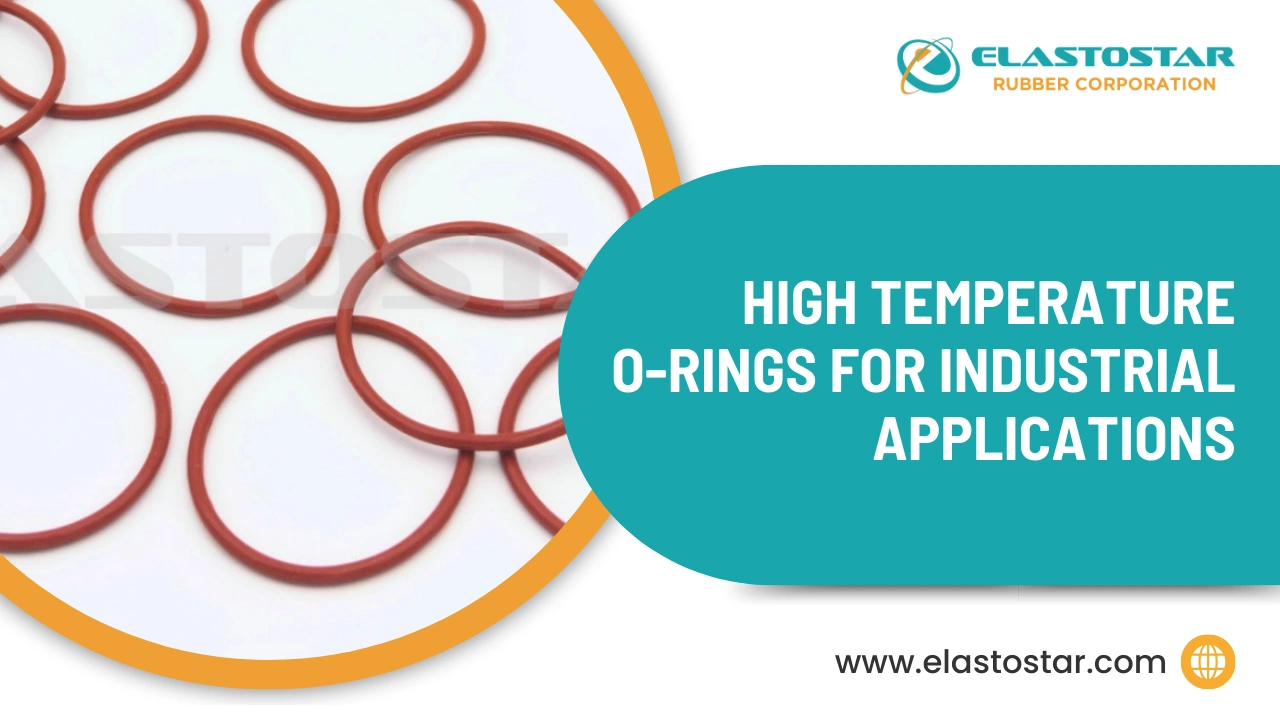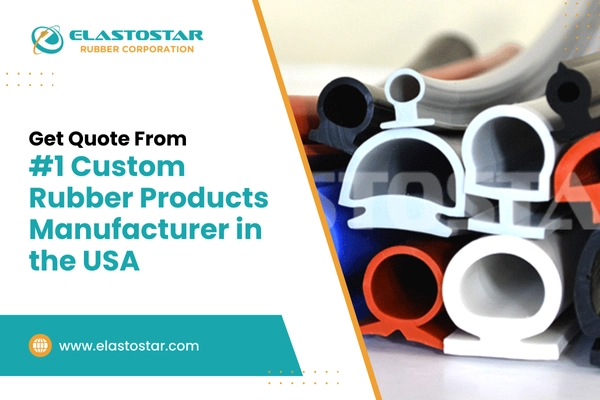FDA food grade silicone tubing plays an important role in maintaining food safety across various food processing and handling applications. It is designed to meet FDA compliance standards, ensuring that the material is non-toxic, odorless, tasteless, and safe for direct contact with food and beverages. This type of food safe tubing is widely used in industries such as food and beverage production, dairy processing, and pharmaceutical manufacturing, where hygiene and safety are essential.
The FDA compliance aspect ensures that the tubing, along with other components like FDA approved seals and detectable gaskets, meets safety requirements for materials that come into contact with consumables. This helps maintain the quality and integrity of food during processing, transport, and storage.
In this guide, we will explore the properties, benefits, applications, and regulatory aspects of FDA food grade silicone tubing, and why Elastostar Rubber Corporation is a trusted provider for industries that prioritize food safety.
Table of Contents
What is FDA Food Grade Silicone Tubing?
FDA food grade silicone tubing is a type of food safe tubing made from FDA compliant silicone, known for its flexibility, durability, and resistance to extreme temperatures. Silicone, as a material, is non-toxic, odorless, tasteless, and highly resistant to chemicals, making it ideal for industries that require hygienic handling of food and beverages.
For tubing to be considered FDA silicone tubing, it must meet strict safety regulations set by the Food and Drug Administration. These regulations ensure that materials used in food processing are safe, non-toxic, and free from harmful chemicals. Silicone FDA approved tubing, like ours, ensures compliance with these standards.
In addition to meeting FDA approved seal standards, our materials are tested to comply with USP Class VI certification, specifically USP CLVI Sections 88 & 87, ensuring the tubing is safe for food and pharmaceutical applications.
Features and Benefits of FDA Food Grade Silicone Tubing
FDA food grade silicone tubing offers a wide range of properties that make it ideal for use in the food and beverage industries.
- Heat resistance
One of the main advantages of heat-resistant silicone is its ability to withstand high temperatures without breaking down. This makes it perfect for hot food and beverage applications, such as in dairy or commercial kitchens.
- Non-reactivity
Non-reactive silicone tubing does not interact with the food or beverages it comes into contact with, preventing contamination or alteration of taste and odor. This ensures that the product quality remains intact during processing.
- Durability
The tubing is designed to be highly durable, resisting wear, tear, and cracking, even in demanding industrial environments. This ensures a long service life and reduced replacement costs.
- Flexibility
Flexible food-grade tubing maintains its shape and structure in various applications, whether it’s being bent, compressed, or twisted. This is essential in food production environments where equipment needs to accommodate constant movement and varying layouts.
- Chemical resistance
The tubing is also resistant to food-safe cleaning chemicals, meaning it can be thoroughly cleaned without degrading or losing its properties.
- Transparency
Another benefit is its transparency, allowing for easy monitoring of liquid flow. This is particularly useful in industries where the visual inspection of fluid levels is required.
These properties make FDA food grade silicone tubing an essential component in maintaining safety and efficiency in food and beverage processing applications.
Common Applications of FDA Food Grade Silicone Tubing in the Food Industry
FDA food grade silicone tubing is widely used across various sectors within the food and beverage industry due to its unique properties, such as non-toxicity, heat resistance, and chemical resilience.
- Food and beverage production
This tubing is commonly used in breweries, wineries, and other food processing plants where liquids like beverages, sauces, or syrups need to be transferred safely. Its non-reactive nature ensures there is no contamination or alteration in the flavor or quality of the liquids. Additionally, FDA approved seals are often used alongside the tubing to maintain safety standards.
- Dairy processing
In dairy facilities, FDA silicone tubing is essential for transferring milk and other dairy products. Its hygienic properties prevent contamination, making it safe for handling and processing milk and dairy liquids. It also works well with metal detectable rubber seals to ensure all equipment parts are traceable and compliant.
- Commercial kitchens
Silicone tubing is often found in commercial kitchen equipment where frequent food contact is involved. Its durability and resistance to high temperatures ensure that it performs well under continuous use in environments that require high sanitation standards. This is where FDA compliant silicone ensures safety in food contact.
- Pharmaceutical industry
Although primarily focused on the food industry, FDA food grade silicone tubing also crosses over into the pharmaceutical sector due to its food-safe properties. It is used in transferring liquids and gels in pharmaceutical production, where safety and cleanliness are critical.
- Baking Industry
Given its ability to hold high temperatures, FDA silicone tubing is commonly used in baking applications for hot food production. Whether it’s transferring liquid batters or handling hot water or steam, the tubing remains stable under high-heat conditions.
FDA Compliance and Regulatory Requirements for Silicone Tubing
To ensure the safety and quality of FDA food grade silicone tubing, manufacturers must comply with strict FDA regulations for materials that come into contact with food. Specifically, 21 CFR 177.2600 outlines the requirements that silicone must meet to be considered FDA-approved.
The tubing must be free from harmful chemicals like BPA and phthalates, ensuring it’s non-toxic and safe for food use. Manufacturers conduct rigorous testing and obtain certifications, including USP Class VI compliance, to confirm that their tubing meets these standards. This guarantees that the tubing is safe, durable, and compliant with all FDA food grade regulations.
By choosing Elastostar Rubber Corporation, you can be confident that our FDA compliant silicone tubing meets these strict standards. Our tubing is rigorously tested, ensuring it is safe for use in food, beverage, and pharmaceutical applications. Elastostar’s dedication to quality and compliance makes us a trusted choice for industries that prioritize safety and durability.
How to Choose the Right FDA Food Grade Silicone Tubing for Your Application?
Choosing the right FDA food grade silicone tubing is important to ensure it works well for your specific needs.
- Temperature requirements
If your process involves very hot or cold temperatures, select FDA compliant silicone tubing that can handle those extremes. For example, hot liquids in baking require heat-resistant FDA silicone tubing, while cold processes need tubing that remains flexible at low temperatures.
- Pressure ratings
Different jobs need tubing that can handle varying pressure levels. For high-pressure systems, such as those in breweries, choose FDA approved silicone rubber tubing that resists bursting under pressure.
- Tubing size and diameter
The size of the tubing should match the type of liquid you’re moving. Thicker liquids, like syrups, need wider tubing, while water or other thin fluids can use smaller tubing. Pick the right diameter to ensure the correct flow rate for your process.
- Type of liquids/fluid
Consider the liquids being transferred. For thick sauces or syrups, wider food safe tubing is ideal, while thinner liquids like water can use smaller tubing.
- Cleaning and maintenance needs
If the tubing requires frequent cleaning, make sure it can withstand regular use of cleaning agents. Tubing made with metal detectable silicone or used alongside FDA approved gaskets is often easier to maintain, as it’s designed for high hygiene standards in food processing.
Proper Cleaning and Maintenance of FDA Food Grade Silicone Tubing
Maintaining your FDA food grade silicone tubing is straightforward with a few key practices. Use food-safe detergents to clean the tubing without degrading it, and avoid harsh chemicals. Rinse thoroughly to remove any residue after cleaning. For sterilization, both heat methods like steam cleaning and food-safe chemical sanitizers work effectively without damaging the tubing.
Regular inspections are essential to check for cracks, discoloration, or thinning, which may signal the need for replacement. Ensure you also monitor the condition of any FDA approved seals or metal detectable silicone components that might be part of your system. Proper storage is also important. Keep the tubing in a cool, dry place away from direct sunlight and avoid folding or compressing it for long periods to maintain its shape.
By following these simple steps, you can keep your food safe tubing in optimal condition, ensuring it remains durable and effective for long-term use.
Comparing FDA Food Grade Silicone Tubing with Other Tubing Materials
| Material | Temperature Resistance | Flexibility | Food-Safe | Durability |
| Silicone | High | Excellent | Yes | High |
| PVC | Medium | Moderate | No | Moderate |
| Rubber | Low | Good | No | Low |
| Plastic | Low | Poor | No | Low |
This table compares the temperature resistance, flexibility, food-safety, and durability of different materials commonly used in tubing applications.
Recommended Reads
- Why FDA-Approved Silicone Rubber is Preferred for Food Industry Gaskets & Seals
- What is FDA Silicone Made Of?
- Know About the Usage Of Food Grade Silicone Tubing

Conclusion
FDA food grade silicone tubing is an important component in ensuring safety and hygiene in the food, beverage, and pharmaceutical industries. Its heat resistance, non-reactivity, and durability make it an ideal choice for applications where cleanliness and efficiency are essential. By complying with strict FDA regulations, manufacturers ensure the tubing is safe, free from harmful chemicals, and suitable for direct food contact. Proper selection, cleaning, and maintenance help extend the tubing’s lifespan, making it a reliable solution for food-safe environments compared to other materials like PVC and rubber.
FAQs
1. What is FDA food grade silicone?
FDA food grade silicone is a non-toxic, odorless, and tasteless material that meets strict FDA standards for food contact. It’s free from harmful chemicals like BPA and phthalates, making it ideal for use in food safe tubing and other food processing applications.
Elastostar Rubber Corporation offers high-quality FDA compliant silicone tubing, ensuring safety and reliability for food and beverage industries.
2. Is all silicone tubing food safe?
No, not all silicone tubing is food safe. Only tubing made from FDA approved silicone rubber is considered safe for direct contact with food. Ensure you choose FDA compliant silicone tubing to meet food safety standards.
3. What silicones are food grade?
Food grade silicones are those that comply with FDA regulation 21 CFR 177.2600. These silicones are non-toxic, free from harmful chemicals, and certified safe for food contact, commonly used in FDA silicone tubing and FDA approved seals.
4. Can FDA silicone tubing handle high temperatures?
Yes, FDA silicone tubing can handle temperatures up to 500°F (260°C), making it perfect for high-heat applications like baking or hot liquid transfers. Elastostar Rubber Corporation provides durable, heat-resistant FDA silicone tubing for demanding food and beverage processes.
5. Is silicone safe for cooking FDA?
Yes, FDA approved silicone is safe for cooking. It’s non-toxic, heat-resistant, and doesn’t release harmful chemicals, making it a reliable choice for cooking tools and food safe tubing used in food preparation.



